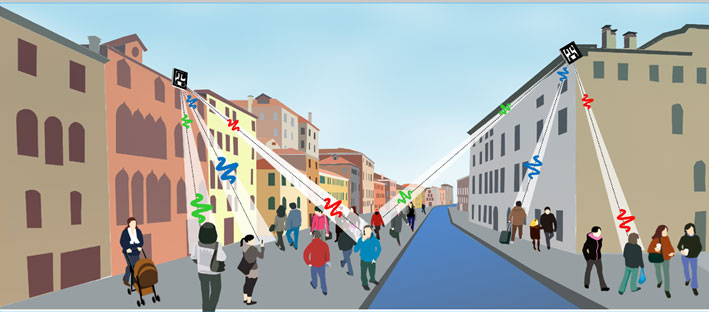by Gregor Dürrenberger (ETH Zürich) and Harry Rudin
Switzerland projects a rural, pastoral image with beautiful countryside and mountains, but it is also a highly industrialised country that is recognised for its precision manufacturing and innovative services. It is the industrialised side of Switzerland that is vitally interested in 5G, the most advanced generation of mobile communication. Currently the country faces social, political and legal challenges that make the 5G roll-out both difficult and costly.
In October 2018 the highest level of government in Switzerland, the Bundesrat, acknowledged that a solid, efficient and reliable IT network infrastructure is the backbone of a successfully functioning economy and society. New digital technologies promise huge improvements in education, vehicle safety, manufacturing, financial transactions, and inter-personal communication.

5G smart antennas deliver energy where it is needed rather than blanketing a large area. Illustration courtesy of Romain Bonjour, IEF, ETH Zurich.
For Switzerland to take advantage of these improvements it needs more wireless capacity. Switzerland has strict regulations regarding non-ionising radiation - in fact, Switzerland’s field-strength limits are ten times more restrictive than those in the European Union. These non-ionising radiation limits are exhausted in most urban locations, meaning that 5G cannot be added on top of the already installed services at these locations. Furthermore, with its dynamic, “smart” antennas, 5G challenges the regulatory framework that governs static antennas.
“Smart” antennas have many names that often stress different characteristics: massive MIMO (massive Multiple Input Multiple Output), switched-beam antennas, dynamic phased-array antennas, or adaptive antenna arrays. We can no longer afford to blanket a large area with communication energy. One key characteristic of 5G is that smart antennas permit transmitted energy to be focussed on a small area where there is an active user. The dynamic aspects of these antennas even allow the system to follow an active user in motion. In addition, the antenna can simultaneously serve multiple users. Such beam-steering implies that non-active, potential users would receive little radiation, in contrast to the current static antennas that cover large areas with communication energy.
Given the importance of 5G to wireless communication in Switzerland, the Swiss Research Foundation for Electricity and Mobile Communication organised a conference in December, 2018, focusing on smart antennas. Professor Jürg Leuthold from the Swiss Federal Institute of Technology in Zurich summarised the technical fundamentals of 5G, stressing the capabilities of smart antennas.
A talk by Hugo Lehman from Swisscom, Switzerland’s largest communication service provider, discussed the difficulties faced by providers in installing the new technology: to stay within radiation limits per cell site, additional cell sites are needed. For the general public, this is a contradiction; more cell sites to protect against non-ionizing radiation.
The problem is exacerbated in 5G due to the dynamic control of the antenna beam. Worst-case radiation summation leads to an overestimation of the average peak radiation by factor of 5-10. This calls for either a change of the current practice of assessing maximum exposure, or an increase in allowed radiated power, or both. Lehmann also reported that preliminary 5G systems are running in six cities in Switzerland to test equipment and coverage. These experimental systems operate under the existing, maximum average transmitted power regulation, even though propagation at 5G’s higher frequencies face increased atmospheric attenuation.
Switzerland’s federal government organisation BAFU (Federal Office for the Environment) implements national laws and ordinances relating to environmental protection. Within BAFU is a section devoted to non-ionising radiation.
Urs Walker from BAFU discussed the political dilemmas faced by the Office: First, the Telecommunications Act and the Environmental Protection Act follow goals that are not easy to harmonise in the field of radiation protection. Second, customers of mobile services and citizens living close to base stations generally have opposing interests. Third, the Swiss Parliament is in disagreement on the issue: the two houses of Parliament are divided: one house was in favour of allowing an increase in the radiated power - by only a few votes; the other was in favour of preserving the present regulation - also by only a few votes.
BAFU is currently investigating the political options as to how to proceed. These options should address: (i) current and future network capacities, including bottlenecks and topologies, (ii) current and future exposure levels of the population in relation to potential roll-out scenarios of 5G networks, and (iii) the current state of evidence on potential health impacts of cell phone radiation from both handsets and base-stations. The report, prepared by a group of experts, should be available in mid-2019 and is eagerly awaited.
The last presentation was given by Andy Fitze from the consultancy Swiss Cognitive. He explored the necessity of 5G for taking advantage of recent developments in blockchain technology, big data, data analytics and artificial intelligence widely accessible to the Swiss economy. His talk was clearly focused on innovation and economic opportunities, not on health risks. The most important risk he identified was missing out on the current development of the digitalisation of society.
An overview and charts from the presentations is available on the web page below, written mostly in German.
Link:
https://kwz.me/hcb
Please contact:
Gregor Dürrenberger, Swiss Research Foundation for Electricity and Mobile Communication, FSM, ETH Zurich,
+41 44 632 5978











